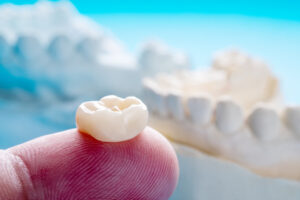Dental Crowns Shouldn’t Fall Out: Learn Why Yours Might
Crowns are a type of dental treatment that can prevent teeth from being extracted if they are badly decaying or damaged. While the average crown will last 10 years or longer, some people will need to replace their crowns sooner. Read on to learn some of the most common reasons they fall out. Contact California Dental Group at (800) 407-0161 if you are in need of setting up a dental appointment.
Decay is the most common reason dental crowns fall out
The most common cause of a crown failing and even falling out is the patient’s failure to keep the crown clean. Even with a complete crown that extends all the way to the gum line, germs can still make their way into the gap between the tooth structure and the crown and cause decay. If you do not brush and floss around your crown on a daily basis, decay will ultimately make its way into the tooth structure underlying the crown, resulting in failure.
Eating certain foods
Eating sticky or chewy foods can easily dislodge temporary crowns (which are used to preserve your teeth while you wait for your permanent crown to be produced by the dental lab). With a permanent crown, however, this should not happen unless another cause, such as deterioration, has already rendered the crown susceptible.
Using your teeth as tools can cause trouble
Many of the same things that may chip or break your teeth can also chip or break a crown. Grinding your teeth at night, eating ice, or using your teeth as tools are all examples of this. Again, unless the crown is already fragile, it is unlikely to come out under these conditions.
Bad dental cement and bad dental work can make a crown vulnerable
Bad dental cement is a relatively unusual reason of a crown breaking out. The integrity of the cement would be affected if it was prepared wrong or became polluted in any way, resulting in a weak bond. Likewise, crowns are more likely to fall out if they were not placed by an expert dentist who took the time and effort to correctly prepare the tooth for the crown.
The tooth must be trimmed down into a peg shape in order to hold a complete crown. The simplest solution is to trim the tooth such that the bottom is considerably broader than the top, allowing the crown to glide on easily. The larger the gap between the top and bottom of the peg, however, the greater the chance of failure, according to studies. After all, a crown that was easy to put on might also be easy to take off. To assist encourage a long service life, a dentist who is proficient in crown insertion will construct the peg with a very little tapering from bottom to top.
You’ll also require a highly experienced dentist if there’s very little tooth structure remaining to hold the crown in place. Your dentist can use techniques like retentive grooves to compensate for a short tooth peg and help build a strong connection for a long service life for your crown.
Skipping regular dental visits
It’s crucial to remember that most crowns have warning signals before they come off. You have a good chance of having these indications recognized early if you visit the dentist on a regular basis. This manner, the crown may be replaced or re-cemented before it comes out completely.
If it has been more than six months since your last dental cleaning and checkup, contact California Dental Group at (800) 407-0161 to make an appointment.





